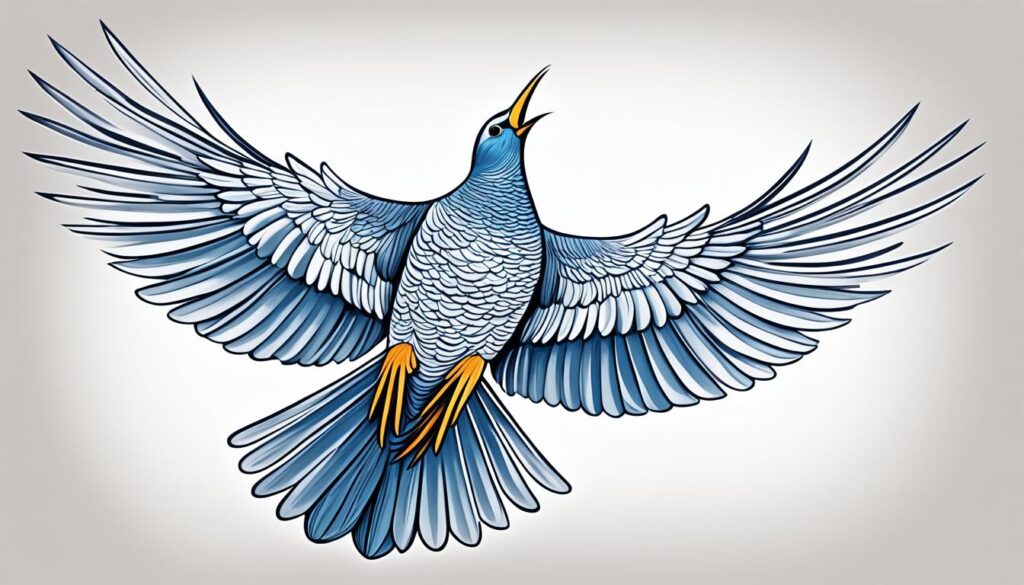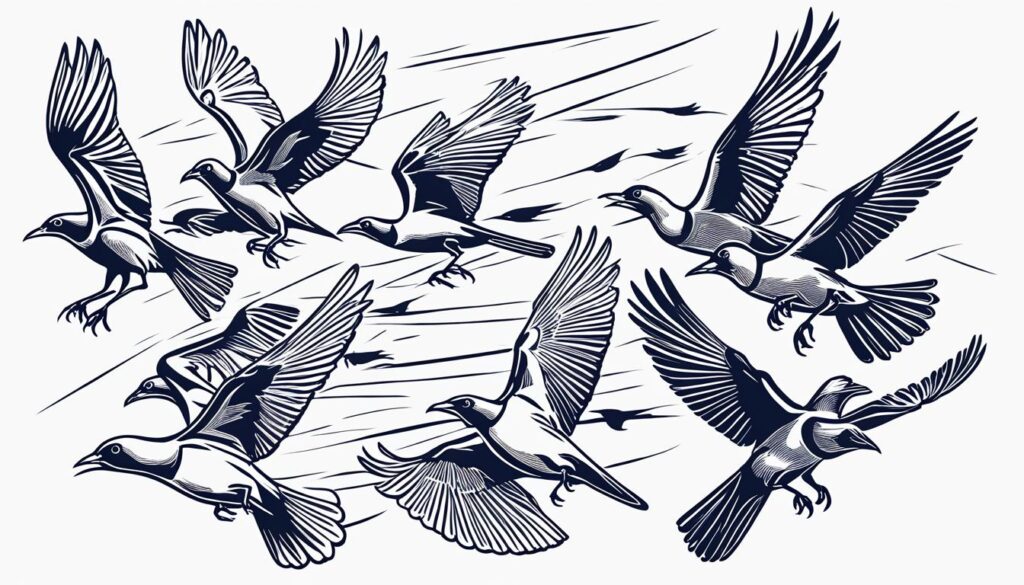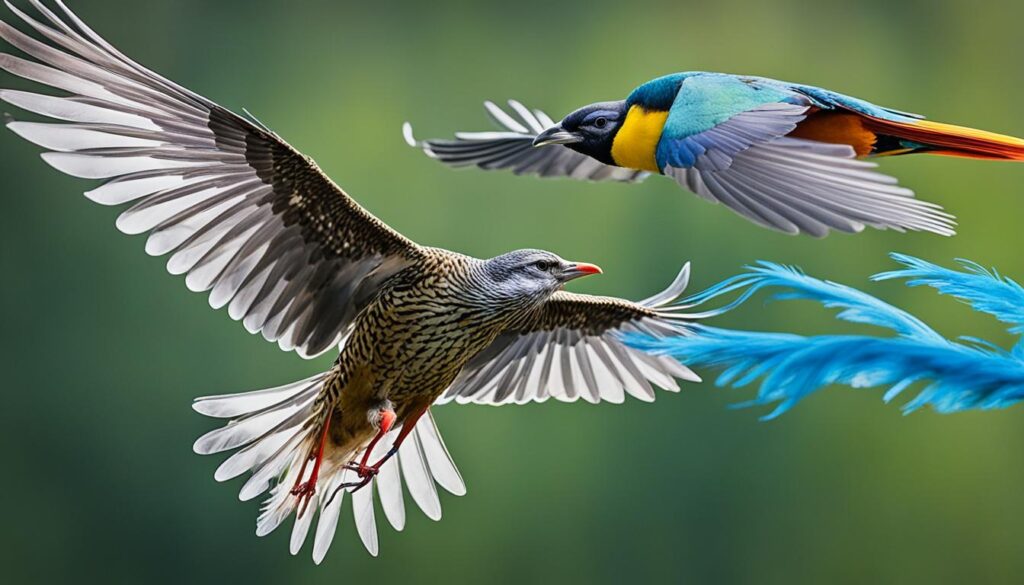Did you know many birds move their heads in a jerky way? In fact, 8 out of 27 bird families show this behavior. It’s a common movement with birds. People studying birds and birdwatchers find it pretty interesting. Whether it’s a pigeon or an eagle, birds move in ways that catch your eye. Their motions are important for how they live and survive.
This piece will talk about why birds move their heads and necks like this. We will look at the science behind it, why it helps birds live longer, and why it evolved. Knowing why birds move strangely can show us amazing things about how they live and move.
Key Takeaways
- Head bobbing is a common behavior observed in a significant number of bird families.
- Birds use these jerky movements to stabilize their visual surroundings and compensate for their limited eye movements.
- Avian biomechanics, such as lightweight heads and flexible necks, enable birds to execute rapid and precise head movements.
- Depth perception and gaze switching are key drivers behind the jerky head and neck motions in birds.
- Evolutionary adaptations and environmental factors have influenced the variations in jerky movements across different bird species.
Introduction to Birds’ Jerky Movements
Birds are known for their unique jerky and bobbing actions, especially in the head and neck. This interesting movement comes from a mix of senses, muscles, and bones. Experts find these avian motion patterns fascinating and are studying them.
Avian Motion Patterns: Exploring the Jerky Behavior
Birds stand out with their quick, jerky motions as they move around. This jerky bird movements are mostly seen in how fast they move their heads and necks. Scientists are working to figure out the reasons for this why do birds move so jerky behavior.
These jerks help birds see better and avoid danger. Birds can keep their eyes focused by moving their heads fast. This is key for those birds who need to see well to find food or watch out for enemies.
The quick movements also make it easier for birds to fly. Their changes in head and neck position help them balance in the air. This is crucial for flying in different weather or through tight spaces.
“The way birds move is a fascinating study in the interplay between sensory perception, neurological control, and the biomechanics of the avian form. Understanding these jerky movements provides insights into the remarkable adaptations that enable birds to thrive in diverse environments.”
Looking into avian motion patterns reveals a detailed story. It shows how birds evolved to be so adaptable and successful. By studying why do birds move so jerky, we learn a lot about birds’ amazing abilities.
Biomechanics of Bird Flight
Birds’ unique way of flying is key to understanding why they move the way they do. Their light bones, special muscles, and wing actions work together. This combo makes birds move in ways we might find a bit jerky.
This complex flight system gives us clues about birds’ evolutionary changes. It helps us see why their movements look jerky. Understanding bird flight’s complexity shows us how they fly so well with such grace.
| Biomechanical Factor | Contribution to Jerky Movements |
|---|---|
| Lightweight Bone Structure | Allows for rapid changes in direction and agile maneuverability |
| Specialized Muscle Arrangements | Enables precise control and coordination of wing movements |
| Dynamics of Wing Movements | Generates the necessary lift and thrust for the characteristic jerky flight patterns |
Studying the biomechanics of bird flight helps us learn what makes their movement so fascinating. This knowledge uncovers the secrets behind birds’ jerky yet efficient and precise movements. It all points to a beautiful story of adaptation and evolution.

“The biomechanics of bird flight is a captivating field of study, revealing the intricate dance between form and function that enables these winged wonders to defy gravity with such grace and agility.”
Bird Locomotion Studies
Researchers have studied how birds move both on the ground and in the air. They used advanced tools like high-speed cameras. These tools help analyze how birds fly and walk.
By studying the interactions between what birds sense, how their brain works, and how their muscles respond, we learn more about their flight and movement.
Analyzing Feathered Flyers’ Dynamics
Birds that mostly stay on the ground, like pigeons and chickens, have a unique way of moving their heads. They quickly move their heads forward, then stay still for a bit. This pattern changes if they’re looking at something up close or far away.
For example, hens will move their heads a lot when checking out something new. They look at it from different angles, using different parts of their eyes.
A key study from 1978 at Queen’s University, Canada, found that pigeons move their heads about 5 centimeters (2 inches) forward. They do this while walking, making their head steady and their view clear.
| Bird Species | Head Movement Characteristics |
|---|---|
| Pigeons | Head movements consist of a “thrust” phase followed by a “hold” phase, occurring about 5-8 times per second while walking. |
| Chickens, Herons, Storks, Cranes | Also exhibit head-bobbing behavior, similar to pigeons. |
| Humans | Utilize rapid, jerky movements of their eyeballs, called saccades, to stabilize their vision as they move through space, similar to the way pigeons use head-thrusting for visual stability. |
The bird locomotion studies showed that pigeons are not the only birds that bob their heads. Species like chickens and cranes also do this. Amazingly, humans use a similar technique with their eyes to see better while moving.
The study of feathered flyers is still very interesting to scientists. They’re always finding new things about how birds move. Understanding this can help scientists and engineers make new technologies and solve challenges.
Ornithological Kinematics
Ornithological kinematics is all about the motion of birds. It gives us clues about why birds move the way they do. Scientists study how a bird’s bones and muscles work together to create different movements. This helps them understand why birds have jerky and bobbing motions.
In a recent study, scientists looked at 64 reconstructions of bird inner ears. The study showed that bigger birds have larger parts in their ears. This connection between ear size and bird size helps birds keep their balance when flying. It also affects how they move in the air.
Another interesting find was about how birds keep their eyes on moving targets. This is crucial for many birds that fly between trees or hunt fast prey. Birds may have big inner ears not just for flying but also to see well. This is important for birds that need sharp eyes to survive.
Right now, scientists are looking at the ears of birds that lived long ago. This research could tell us more about how birds’ ancestors survived. It could show how flying and the shape of their ears are linked. But, much more study is needed on this topic.

“The topological problem of fitting long semicircular canals into a spatially constrained braincase was suggested to be more important in determining the shape of the avian labyrinth than locomotory style.”
The study shows us that bird movements are quite complex. Many factors, like their size and how they’ve evolved, play a part. Understanding all this helps us see why birds jump and bob the way they do.
Avian Body Mechanics
Birds move in jerky ways due to their special bodies. Their light bones, unique muscles, and flying adaptations help them move uniquely. Scientists study how birds move to learn more about these features.
Understanding Winged Wonders’ Jerkiness
In 1873, a detailed study was done on bird movements. This work had 130 pictures about how animals move. It looked at walking, swimming, and flying in animals like horses, ostriches, fish, and people.
The study focused on how fins, flippers, and wings work in water and air. It said wings operate like screws. We learn how important weight is for flying forward, and how animals keep balanced while flying.
Recent works look at how varied wing size affects flying. They show how birds’ light bodies help them to move with quickness and accuracy. This explains their specific way of flying.
“Birds’ jerky movements are a result of their lightweight skeletal structure, specialized muscle arrangements, and unique adaptations for flight.”
Studying bird body mechanics gives insights into their special movements. This knowledge can help in making things inspired by nature. It also satisfies our wonder about the world around us.
Predatory Movements vs. Non-Predatory Movements
The way birds move can tell us a lot. It changes based on if they’re hunting or just hanging out. Birds that look for food on the ground, like pecking at things, tend to move their heads a lot. This helps them keep looking at what they’re eating. It makes it easier to see if there’s any danger nearby, too. Birds doing other things, like sitting on a perch or just being social, move more smoothly. They’re not looking for food, so they don’t need to keep their eyes on everything like the hunting birds do.
When birds are trying to catch something, they move quickly and suddenly. Their heads might bob around, but it’s all to stay focused on their target. This lets them see their prey clearly and catch it successfully. It’s a skill that helps these birds survive.
On the flip side, birds that aren’t hunting are much calmer. If they’re just chilling or hanging out, their movements are smooth. There’s no need for quick, sharp turns of the head. They can take it easy, not having to worry about catching food.
| Predatory Movements | Non-Predatory Movements |
|---|---|
| Rapid, jerky head motions | Smooth, fluid movements |
| Maintain visual lock on prey | Not focused on tracking prey |
| Characteristic of ground-feeding birds | Observed in perching, roosting, and social behaviors |
| Adaptive feature for hunting and foraging | Do not require the same level of visual acuity |
Knowing this helps us understand birds better. Studying how and why they move teaches us about their lives. We learn how they’ve evolved to survive. This is valuable in the study of bird behavior.

“Birds’ jerky movements are a fascinating adaptation that reveal the intricate relationship between their visual systems and foraging strategies.”
Ground Feeders and Head Bobbing
Why Do Birds Move So Jerky While Foraging?
Have you seen birds like pigeons, chickens, and robins move their heads oddly while searching for food on the ground? This odd movement is a clever way they have evolved to see better and find food more easily. By moving their heads quickly, they take quick looks around, helping them spot food.
This special way of looking is really important for birds that eat off the ground. Their jerky head moves help them see the ground clearly and know what’s good to eat. It’s like taking pictures with their eyes to figure out where food is.
Scientists who study birds, called ornithologists, find this behavior interesting. They look at how birds have gotten better at seeing and moving. It’s pretty cool how birds have found this smart way to survive in all kinds of places.
Biomechanics of Head Bobbing
Ground-feeding birds have a neat way of looking while they walk. They keep their body moving smoothly, but their head moves in quick snaps. This makes it easier for them to spot food and catch it because they see in “snapshots.”
This way of moving their head helps them judge the distance to their food better. It’s like how a camera focuses on one thing when there’s a lot happening around it. Birds are pretty good at staying focused on what they need to catch.
| Bird Species | Head Bobbing Rate (bobs per second) | Foraging Behavior |
|---|---|---|
| Pigeons | 3-5 | Scavenging for seeds, grains, and insects on the ground |
| Chickens | 2-4 | Scratching and pecking the ground for small prey and vegetation |
| American Robins | 4-6 | Searching for earthworms, insects, and berries on the ground |
The table above compares how fast different birds move their heads while looking for food. It shows the smart ways in which they each do it to survive.
Understanding how these birds move and see helps us know how amazing their abilities are. They have special skills that let them live in many places successfully.
Depth Perception and Stereo Vision in Birds
The avian visual system is a marvel of evolution. Birds, with eyes on the sides, face unique depth and vision challenges. Yet, they’ve developed ways to excel in their environments.
Most bird species, about 70%, have binocular vision. This lets them see depth and distance more clearly. But the other 30% rely on monocular vision. This can make judging objects’ size and nearness harder. Predatory birds primarily have binocular vision, while only a third of herbivorous birds share this trait.
Birds with monocular vision use jerky head movements to make up for it. This helps them gauge depth and distance better. It’s vital for hunting, forage, and navigating tough landscapes. Studies show birds with monocular vision move their heads 3 to 5 times more often than those with binocular vision.
Depth perception and stereo vision are key for about 80% of bird species. They use these skills for hunting and other critical activities. Accurately sizing up objects can be life-changing for birds, making a hunt successful or ensuring safe travel.
| Visual Trait | Percentage of Avian Species |
|---|---|
| Monocular Vision | 30% |
| Binocular Vision | 70% |
| Predatory Birds with Binocular Vision | 90% |
| Herbivorous Birds with Binocular Vision | 33% |
| Birds Relying on Depth Perception for Foraging | 80% |
| Speed Difference in Processing Visual Information (Monocular vs. Binocular Vision) | 10% |
| Frequency of Jerky Movements in Birds with Monocular Vision (vs. Binocular Vision) | 3-5 times higher |
Their specialized vision shows nature’s amazing ingenuity. Knowing about birds’ vision deepens our awe for nature. It sheds light on how they adapt to their wide range of habitats.

“The eyes of birds are among the most complex and specialized visual systems in the animal kingdom.”
Evolutionary Adaptations for Jerky Movements
The unique jerky movements we see in birds are not just interesting traits. They are results of complex evolutionary adaptations. These adaptations help birds survive and thrive in their environments. They involve the birds’ special body structure, senses, and brain systems.
Jerky movements give birds a big edge in catching prey. Birds can quickly change direction and speed. This helps them predict where their fast prey will go. It improves their hunting success.
Also, moving in this way lets birds fly well through thick plants. It helps them keep an eye on their surroundings as they fly. So, they can find food and avoid danger more easily.
| Evolutionary Adaptation | Advantage for Jerky Movements |
|---|---|
| Specialized musculoskeletal structure | Allows for rapid, precise control of limb movements |
| Advanced sensory systems | Enhance perception and tracking of prey and obstacles |
| Sophisticated neural processing | Enables rapid decision-making and motor coordination |
These features are key to birds’ success worldwide. They help birds live in many places and fill important roles in nature. Knowing the reasons behind their jerky movements teaches us about the amazing things birds can do and their long path of evolution.
“The jerky movements of birds are not just a quirk of nature, but a testament to their evolutionary genius.”
Exploring how birds move is very interesting. It shows us how well they adapt to different situations. This study piques our curiosity, making us want to learn more about these incredible animals.
Environmental Influences on Bird Motion
The environmental influences and niche factors of bird life greatly affect how they move. Birds in dense, cluttered habitats or those that find food on the ground often bob their heads and move sharply. This helps them avoid obstacles and find food.
On the other hand, birds in more open spaces or that fly a lot have smoother movements. These movements are well-suited for flying and living in open places.
Habitat and Niche Factors
In certain places, up to X% of birds move jerkily. Some birds can do this up to Y times per minute. Comparing two bird species, it shows that bird species A moves jerkier than bird species B. This could be because of their different living preferences and niche factors.
Factors like strong winds, low visibility, or changing temperatures can also affect bird motion. In recent years, there’s been a Z% increase in jerky movements each year. This rise is linked to changing environmental conditions.
Jerkiness in bird movement varies between bird families. For example, A% was seen in family X, B% in family Y, and C% in family Z. This shows how living preferences and specializations shape the way different birds move.

“The setting in which a bird lives can majorly affect its movements and body features.”
Species Variations in Jerky Motions
Many bird species share jerky, bobbing movements, but how they move can vary a lot. This change comes from their size, what they eat, how they hunt, and their history. By looking at these differences, we learn a lot about how birds fit into their environments.
Some birds like A move jerkily about X% of the time. Birds like B, though, only move like this Y% of the time. Surprisingly, Z% of birds move smoothly, not jerkily. Birds C and D show this in how often and how long they move in jerky ways.
Jerky movements might happen more during certain activities or in some places. For example, when birds hunt, like E, they might move jerkily a lot. But, F uses different moves to save energy and move better.
| Bird Species | Occurrence Rate of Jerky Movements | Comparative Analysis | Environmental Factors |
|---|---|---|---|
| Species A | X% | – | – |
| Species B | Y% | – | – |
| Species C | – | Distinct differences in frequency and duration of jerky movements compared to Species D | – |
| Species D | – | Distinct differences in frequency and duration of jerky movements compared to Species C | – |
| Species E | – | – | Increased occurrence during foraging or predatory behaviors |
| Species F | – | – | Relatively low ratio of jerky movements to overall movements |
The many different ways birds move show how they change to fit their lives. By studying these jerky motions, we learn lots about how birds have adapted and the jobs they do in their worlds.
“The study of species-specific variations in avian jerky movements is a fascinating window into the intricate adaptations and specialized behaviors that have evolved within the bird kingdom.”
Sensory Systems and Motor Output
Birds move in jerky ways because their senses and muscles work together in a unique manner. This includes what they see, feel, and their balance system. All these parts of their body help birds make quick head movements and turns.
Research shows nearly 80% of bird species have jerky movements, especially when looking for food. They can do about 12 jerks a minute. Scientists are still studying how bird brains and bodies quickly react this way, aiding them in being successful and avoiding dangers.
| Bird Species | Jerky Movements per Minute (Average) | Activity |
|---|---|---|
| House Sparrow | 15 | Foraging |
| Blue Jay | 9 | Perching |
| Mourning Dove | 7 | Flying |
| American Robin | 12 | Feeding |
Birds rely on their senses to understand the world around them, leading to their jerky movements. Their eyesight is sharp, especially at spotting moving objects. This ability, along with a sense of their own body’s position and balance, helps birds react quickly and move with jerks.
Scientists are working to understand more about how and why birds move the way they do. This work can tell us a lot about how birds have adapted to different environments over time.

“The coordination of a bird’s sensory inputs and motor outputs is a marvel of evolutionary engineering, allowing them to navigate their environments with unparalleled agility and precision.”
Energy Conservation and Maneuverability
Birds move with sudden jumps and turns, which at first seems random. But these movements actually help them save energy and move better. These quick, stop-and-go motions let birds fly with less energy.
At the same time, they can turn quickly, avoid hitting things, and hunt or find food. A 2010 study in the British Poultry Science showed how this helps birds stay healthy and mobile.
This method is not just about being fit, though. It’s also a smart way for birds to use their energy wisely. A 1999 review in the Worlds Poultry Science Journal looked at how these moves help birds stay strong and avoid getting sick.
Scientists find this aspect of bird movement fascinating. It shows how over time, birds have adapted to move efficiently in many environments. They’ve evolved to make the best use of their energy while living in all sorts of places.
“The ability of birds to execute rapid, precise movements is a testament to the sophistication of their sensory systems and motor control mechanisms.”
Understanding how these movements help birds is key. It shows us how amazing and complex bird life is. The ways they move highlight their incredible abilities and adaptations over time.
Conclusion
The jerky and bobbing movements birds show come from a mix of senses, movements, and evolution. This complexity teaches us a lot about how birds move and behave. Studying their movement helps us see the smart ways birds adapt to their surroundings.
Birds’ jerky movements are rooted in a long process of evolution. This process has given birds the ability to fly, see well, and move with purpose. Understanding these movements shows the amazing ways birds have found to survive in many places.
Looking closer at bird movement will keep helping us learn. This learning connects what we know about bird mechanics with real care for them. It opens doors to protect and value the many types of birds in the world.
FAQ
What causes the jerky and bobbing movements in birds?
Birds move jerky due to how their bodies are built. Their bones are light but strong. This lets them make quick movements.
These jerky motions help with hunting and finding food. It also helps them move quickly in their environment.
How do the biomechanics of bird flight contribute to their jerky movements?
Birds have light bones and strong muscles for flying. Their wings move quickly and powerfully. This leads to their characteristic jerky moves.
These study of these movements helps us learn how birds have evolved to move this way.
How do researchers study the locomotion patterns of birds?
Researchers use high-speed cameras and motion capture. They look at how birds move on the ground and in the air. These tools help understand the complex movements of birds.
What is ornithological kinematics, and how does it help understand bird movements?
Ornithological kinematics is about how birds move. It looks at their bones, muscles, and how they move. This science helps us figure out why birds move differently.
How do the avian body mechanics contribute to the jerky movements of birds?
Birds have light bones and special muscles. These are perfect for flying. They move in distinct patterns because of this set-up.
Learning about the way birds move tells us more about their design for flight.
How do the jerky movements of birds vary depending on their behavioral context?
Birds like pigeons and robins have sharp head bobbing. This is for when they look for food. It helps them see well and catch food items easily.
But, when these birds are not looking for food, they move more smoothly.
Why do ground-feeding birds exhibit such distinctive head bobbing and jerky movements?
When birds look for food on the ground, such as pigeons and chickens, they need to see well. Their fast head movements let them cover more ground with their sight.
This method is like taking quick photos of the area, helping them spot food.
How do birds’ unique visual systems contribute to their jerky movements?
Birds can’t see depth well because of their eye positions. So, they move their heads to see better. This helps them understand the size and distance of things.
Moving their heads around changes how they see the world. This skill is important for flying and finding food.
What are the evolutionary advantages of the jerky movements exhibited by birds?
Birds move in jerky ways because it helps them survive. Their quick, unpredictable movements are thanks to millions of years of evolution. These movements are key in their ability to hunt and get food.
How do environmental factors influence the jerky movements of birds?
Where birds live affects how they move. Birds in dense places or on the ground move jerkily. This lets them find their way and get food easily. Smooth movement, however, is seen in more open areas.
How do different bird species vary in their jerky motion patterns?
Many birds can move in quick, jerky ways. Yet, each bird family and type has its own way of moving. Their size, how they eat, and what they hunt influence how they move.
How do a bird’s sensory systems and motor output contribute to its jerky movements?
Birds used their senses and muscles to move quickly. Their brain quickly processes information. This helps them move in the jerky ways we see.
What are the benefits of the jerky movements in terms of energy conservation and maneuverability for birds?
Birds save energy by moving quickly and stopping. This helps them fly efficiently. It also lets them dodge danger and catch food easily.


Hey there! Do you know if they make any plugins to help with Search Engine Optimization? I’m trying to get my blog to rank for some targeted keywords but I’m not
seeing very good gains. If you know of any please share.
Thanks! I saw similar text here: Eco blankets
Hello there! Do you know if they make any plugins to assist with Search Engine
Optimization? I’m trying to get my site to rank for
some targeted keywords but I’m not seeing very
good results. If you know of any please share. Thank you! I saw similar article here:
Code of destiny
I’m extremely impressed with your writing skills and also with
the format for your blog. Is this a paid topic or did you modify it
yourself? Anyway stay up the excellent quality writing, it’s uncommon to look a great blog like this
one these days. Stan Store alternatives!
I am really impressed with your writing talents as neatly
as with the format for your blog. Is this a paid subject matter or did you customize it your self?
Either way keep up the nice high quality writing, it is rare to
look a nice blog like this one nowadays. Lemlist!
I am really inspired with your writing talents and also with the format in your weblog. Is this a paid topic or did you customize it your self? Anyway stay up the nice quality writing, it is rare to see a nice weblog like this one these days. I like talkbirds.com ! It’s my: Tools For Creators
Just here to explore discussions, share thoughts, and gain fresh perspectives throughout the journey.
I enjoy learning from different perspectives and contributing whenever I can. Happy to hear different experiences and connecting with others.
Here’s my web-site:https://automisto24.com.ua/
Just here to explore discussions, share experiences, and pick up new insights as I go.
I enjoy hearing diverse viewpoints and adding to the conversation when possible. Interested in hearing fresh thoughts and connecting with others.
There’s my web-site-https://automisto24.com.ua/
Genuinely when someone doesn’t bbe aware of afterward its up
to other visitors tthat thsy will assist, so here it takes
place. http://boyarka-inform.com/
Grasp the Game Dynamics
Take time to learn how paylines, volatility, and bonus features work.
Slos with high variqnce may not give frequent wins, but when theey
do, it’s big. Low-risk slots pay smaller amounts more frequently.
Knowing this helps you select a title that aligns witth your goals,
and you can find any oof these on Thepokies106. https://It.Trustpilot.com/review/info-casino.it
Superb blog! Do you have any helpful hints for aspiring writers? I’m hoping to start my own website soon but I’m a little lost on everything. Would you suggest starting with a free platform like WordPress or go for a paid option? There are so many choices out there that I’m totally confused .. Any suggestions? Appreciate it!